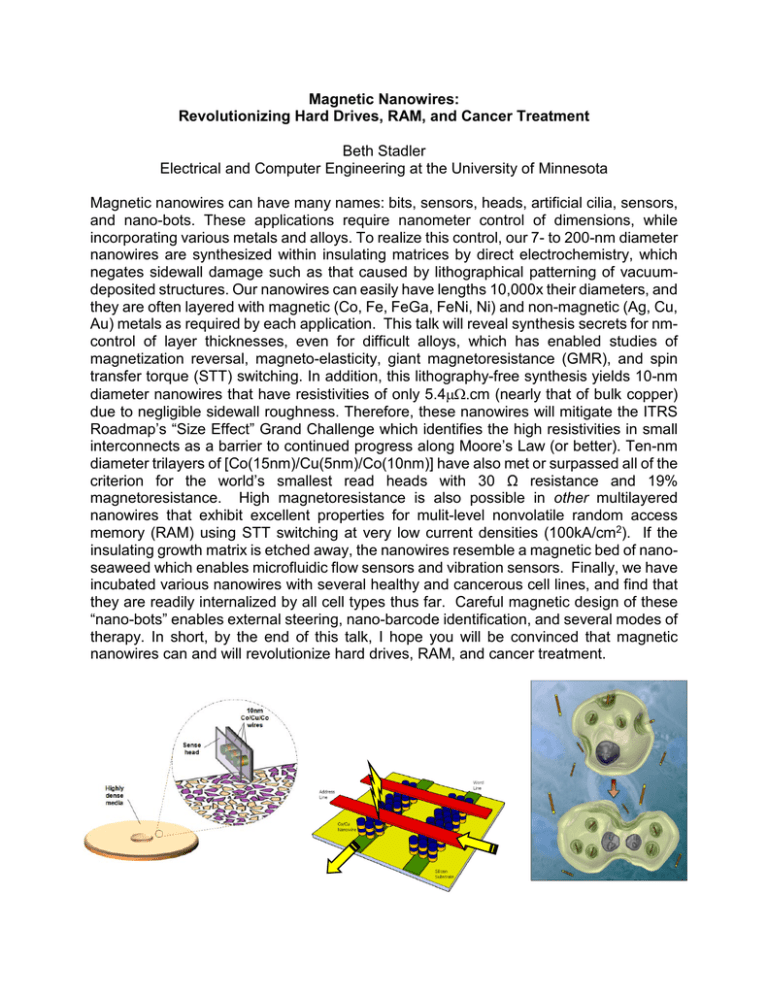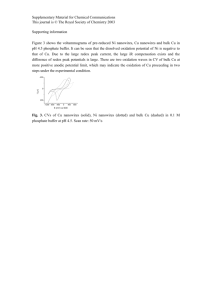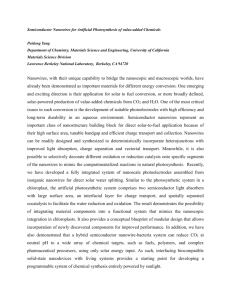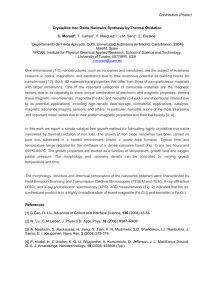Magnetic Nanowires: Revolutionizing Hard Drives, RAM, and Cancer Treatment Beth Stadler
advertisement

Magnetic Nanowires: Revolutionizing Hard Drives, RAM, and Cancer Treatment Beth Stadler Electrical and Computer Engineering at the University of Minnesota Magnetic nanowires can have many names: bits, sensors, heads, artificial cilia, sensors, and nano-bots. These applications require nanometer control of dimensions, while incorporating various metals and alloys. To realize this control, our 7- to 200-nm diameter nanowires are synthesized within insulating matrices by direct electrochemistry, which negates sidewall damage such as that caused by lithographical patterning of vacuumdeposited structures. Our nanowires can easily have lengths 10,000x their diameters, and they are often layered with magnetic (Co, Fe, FeGa, FeNi, Ni) and non-magnetic (Ag, Cu, Au) metals as required by each application. This talk will reveal synthesis secrets for nmcontrol of layer thicknesses, even for difficult alloys, which has enabled studies of magnetization reversal, magneto-elasticity, giant magnetoresistance (GMR), and spin transfer torque (STT) switching. In addition, this lithography-free synthesis yields 10-nm diameter nanowires that have resistivities of only 5.4µΩ.cm (nearly that of bulk copper) due to negligible sidewall roughness. Therefore, these nanowires will mitigate the ITRS Roadmap’s “Size Effect” Grand Challenge which identifies the high resistivities in small interconnects as a barrier to continued progress along Moore’s Law (or better). Ten-nm diameter trilayers of [Co(15nm)/Cu(5nm)/Co(10nm)] have also met or surpassed all of the criterion for the world’s smallest read heads with 30 Ω resistance and 19% magnetoresistance. High magnetoresistance is also possible in other multilayered nanowires that exhibit excellent properties for mulit-level nonvolatile random access memory (RAM) using STT switching at very low current densities (100kA/cm2). If the insulating growth matrix is etched away, the nanowires resemble a magnetic bed of nanoseaweed which enables microfluidic flow sensors and vibration sensors. Finally, we have incubated various nanowires with several healthy and cancerous cell lines, and find that they are readily internalized by all cell types thus far. Careful magnetic design of these “nano-bots” enables external steering, nano-barcode identification, and several modes of therapy. In short, by the end of this talk, I hope you will be convinced that magnetic nanowires can and will revolutionize hard drives, RAM, and cancer treatment. Bethanie Stadler works on the integration of nanomagnetic and photonic materials with a variety of platforms to allow the development of practical devices and systems. This includes magnetic nanowires for magnetoelectronics (including hard drive heads), microfluidic flow sensors and actuators, acoustic/vibration sensor applications, and cellular biomarkers. In photonics, Stadler works on the integration of magnets, magneto-optical garnets waveguides, and nanostructures for magnetophotonic crystals with semiconductor platforms for isolator and sensor applications. Stadler received her PhD from MIT in 1994 and her B.S. from Case Western Reserve University in 1990, both in Materials Science and Engineering. She held a NRC postodoctoral fellowship at the Air Force Rome Laboratory before joining Electrical and Computer Engineering at the University of Minnesota, where she is also on the Graduate Faculty of Chemical Engineering and Materials Science. She has been awarded the NSF CAREER award and a McKnight Presidential Fellowship. Stadler has served both as Director and Secretary of the Materials Research Society, and has been asked to teach for the IEEE Magnetic Summer School in Chennai India and in Assis Italy.








